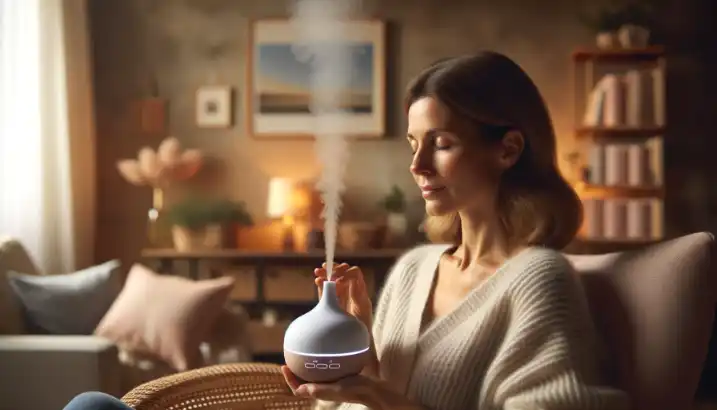Can You Mix Essential Oils in a Diffuser?
I recently discovered how amazing it feels to diffuse custom essential oil blends throughout my home. As soon as I arrive home from work and smell my personalized mix of lavender, cedarwood and ylang ylang, I instantly feel more relaxed and at peace.
But when I first started exploring essential oils, I wasn’t sure if I could combine different oils in my diffuser. I had heard that certain oils pair well together, while others don’t. Can you actually mix essential oils in a diffuser?
The answer is yes – you absolutely can and should mix essential oils to create custom diffuser blends! Doing so allows you to enjoy complementary scents and benefits in one invigorating aroma.

In this post, we’ll explore the world of essential oil blending for diffusers. Read on to learn why you should mix oils, blending tips and tricks, how to pick complementary oils, making skin-safe blends, and more.
Why Diffuse Blended Oils?
Before jumping straight into the mixing methods, you might be wondering…why even blend oils for your diffuser in the first place? Here are some of the prime benefits:
Enhance Aromatherapy Benefits
While individual oils offer their own advantages, combining complementary oils allows you to enhance the overall aromatherapeutic effects.
For example, blending the clarifying properties of lemongrass with the soothing qualities of lavender creates an oil mix ideal for both invigorating and calming your mood.
Customize Your Perfect Aroma
Blending oils together enables you to create a fully personalized scent experience. You can craft an aroma with your favorite notes, whether they be sweet, woodsy, herbal, spicy or beyond. The options are endless!
Set a Specific Mood or Atmosphere
In the same vein, blended essential oils allow you to permeate any space with a tailored ambience. Diffuse energizing blends for an afternoon work session, relaxing oils for pre-bedtime calm, or seasonal scents to conjure the holidays.

Now that you know why you should blend oils for your diffuser, let’s get into the mixing methods…
Tips for Blending Your Own Oil Mixes
If you’re new to mixing essential oils, the process can seem a bit intimidating. But following these simple tips will set you up for blending success:
Start Simple
I recommend starting off by blending just 2-3 complementary oils at a time until you get the hang of combining scents. Testing out pre-made synergy blends can also help you learn how to pair oils effectively.
Balance the Notes
Pay attention to essential oil notes – categories that indicate how quickly an oil’s scent permeates then dissipates. Balancing top, middle and base notes creates a harmonious aroma.
- Top notes first hit the nose with bright, light scents
- Middle notes offer medium aromas that balance the blend
- Base notes provide subtle, lingering foundational scents
Test Out Small Batches
Only mix up small amounts of each blend before diffusing it widely. This allows you to tweak ratios if needed.
Consider Benefits and Scents
Choose oils that offer complementary advantages like energy boosting and calming properties. But also ensure the scents work well together, like fruity, floral and citrus.

Next, let’s explore some of the best oils to blend together in your diffuser…
Top Oils to Mix and Diffuse
With hundreds of essential oils out there, deciding which ones to blend can get overwhelming fast. Here are some can’t-fail categories to help narrow your options:
For Energy: Grapefruit, Lemon, Peppermint
These bright, stimulating oils will help boost lagging energy levels.
For Calm: Lavender, Bergamot, Ylang Ylang
Blend these floral, woodsy oils for instant relaxation.
For Grounding: Cedarwood, Sandalwood, Frankincense
Diffuse these base-note oils for centered, rooted tranquility.
For Uplifting: Orange, Lime, Lemon
Clear your mind and lift your mood with the fruity power of citrus.
Don’t be afraid to get creative and daring with your mixtures! Once you become more comfortable blending oils by category, you can start to experiment across categories to invent unique diffuser creations.
Now, let’s explore how to make diluted, skin-safe essential oil blends…
Making Diluted Essential Oil Mixes
While the bulk of your custom oil blends will likely be diffused and diluted in water, you may also want to use them topically. However, applying potent oils directly can sometimes irritate skin.
The solution? Diluting your essential oils properly with a carrier oil before skin application.
Add a Carrier Oil
Common carrier oils used to dilute essential oil mixes include:
- Coconut oil – Perfect for sweetening citrus blends.
- Jojoba oil – Easily absorbs into skin.
- Almond oil – Nutty scent works well with spicy oils.
Dilute oils at the proper ratios to ensure safety and effectiveness:
- For adults, aim for 2-5% dilution (12-15 drops of essential oils per ounce of carrier oil)
- For children, limit oils to .25-1% dilution (3-6 drops per ounce of carrier oil)
Patch Test Diluted Oils
It’s crucial to test diluted essential oil blends on a small patch of skin first, as sensitivities can develop over time. Simply mix your blend, apply to your inner arm, and look for irritation over 24-48 hours before wider use.

Now that you know how to make custom diffuser blends, let’s cover usage and storage…
Using and Storing Your Blends
Like all potent plant compounds, proper usage and storage of your essential oil mixtures helps them retain maximum benefits. Follow these tips for success:
Clearly Label Bottles
Always store your blends in opaque, airtight bottles clearly labelled with oil names, proportions, and creation dates. Mislabelling can lead to irritation if you mistake oils.
Follow Diffuser Directions
Once mixed and bottled, add your oil blend to your diffuser according to the device’s directions. Most accept around 15-25 total drops per use.
Tip: Add drops slowly and pause to take a whiff. You can always add more – but removing oil is trickier!
Keep Away From Light and Heat
Don’t stash diffuser blends on sunny windowsills or near cooking areas, as light and warmth degrade integrity. Store in cool, dark spaces instead.
Enjoy experimenting with and diffusing your custom, healthy essential oil blends! Just remember – start simple, blend complementary scents and benefits, dilute and patch test for skin wellness, monitor your diffuser, and store your mixes properly.
Now you can answer confidently when someone asks, “Can you mix essential oils in a diffuser?”
